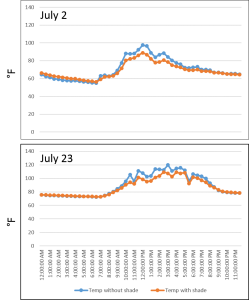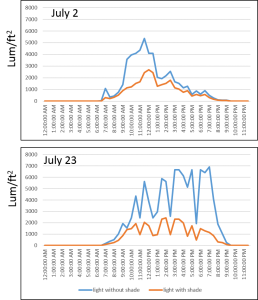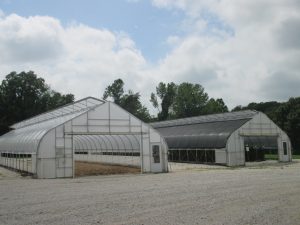We have discussed the pros and cons of using shade cloth for growing high tunnel tomatoes in this article https://vegcropshotline.org/article/whether-to-put-shade-cloth-on-high-tunnel-tomatoes/
Shade cloth helps with reducing temperatures inside the high tunnel. But it also reduces light intensity that is essential for photosynthesis. To better understand to what extent can temperature and light reduced with a shade cloth applied on top of a high tunnel, We did a comparison this summer at Southwest Purdue Agricultural Center, Vincennes, IN, with one high tunnel applied with 30% black shade cloth, and the adjacent one did not (Figure 1). The following figures (Figure 2 and 3) illustrate how temperature and light levels in the high tunnel were affected by the shade cloth in a typical sunny (July 23) and a cloudy day (July 2).
On both days, about 10 degree difference of maximal temperatures were observed between the two tunnels. On the sunny day of July 23, the highest temperature recorded in the high tunnel without shade cloth was 119 °F, while the highest temperature in the high tunnel with shade cloth was 109 °F. On the cloudy day of July 2, maximal temperature in high tunnels without and with shade clothes were 97 °F and 88 °F, respectively. On both days, shade cloth did not affect the night temperatures. The difference of light intensities varied dramatically during the day. When light intensity was high (above 6,000 lum/ft2), the shade cloth reduced light intensity more than 60%, even though the shade cloth used in this case was marketed as 30% shade. During cloudy period, for example in the afternoon of July 2, light reduction was around 30%.
We applied the shade cloth in middle June without taking it off throughout the summer. We observed less yellow-shoulder tomatoes compared with the previous years. However, extended internode of tomato plants indicate the plants are suffering from light stress. In addition, the extended shoot length increase plant height. We need to tie the tomatoes (determinate type) more frequently to prevent them falling down. With this observations, we suggest growers using shade cloth with caution. Only use shade cloth with moderate shade levels (30% or less), and if it is possible, apply it in the days when maximal temperature is above 90 °F and take them off when temperature drops.

Figure 1. Temperatures in high tunnel with and without shade in a typical sunny and a cloudy day in the summer 2016.

Figure 2. Light intensity in high tunnels with and without shade cloth in a typical cloudy (July 2) and a sunny day (July 23) in the summer 2016.
